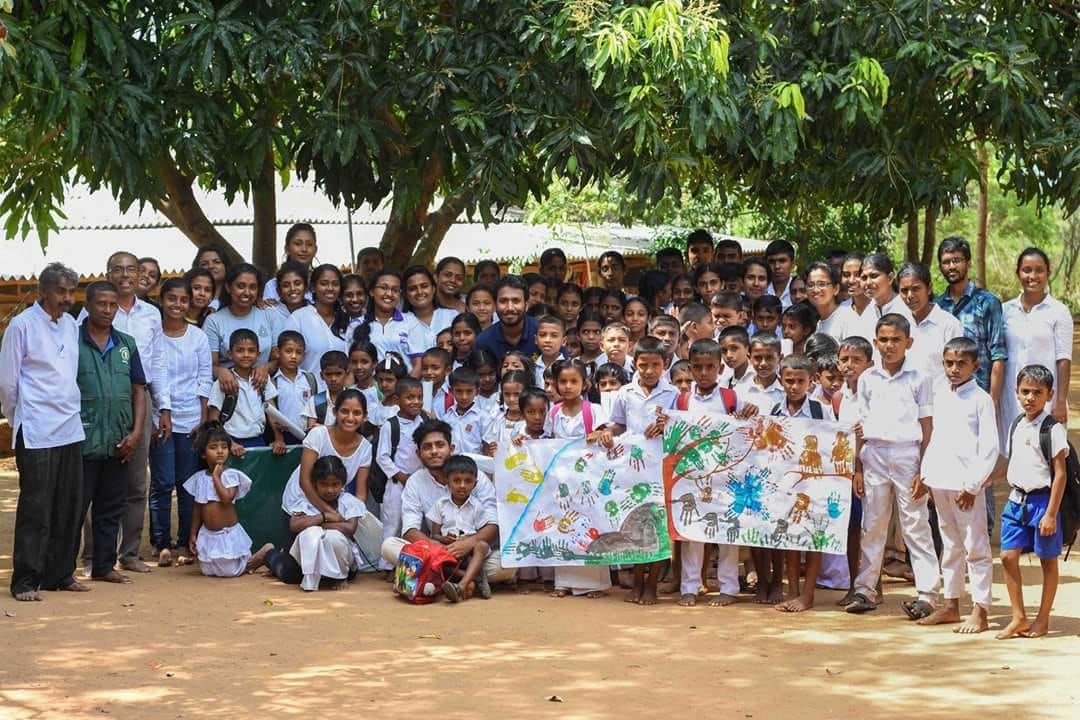What is the most valuable gift you could give someone? It is the gift of knowledge and understanding.
All around Sri Lanka are areas protected for wildlife that are home to many different but unique forms of life. The community that live with these wild animals and plants interact mostly with them. The knowledge and love for nature must be instilled in them from their childhood. Better understanding of these resources will help them to make good use of it and protect it for the future without prompting to destroy them.
With the dawn of 07th of September 2018, the zoology and environmental science special degree students left the University of Colombo to reach Wasgamuwa National Park for our Field Practicals on Conservation Biology and Wildlife Management. Among our objectives to learn field craft and stakeholder management, we organized an educational program for the children of the community near the National Park hoping to share our knowledge and inspirations with them for better coexistence with their natural resources.
“Hands to Bloom” – the Wasgamuwa Community Service Program was an educational program organized as part of the Wasgamuwa Field Workshop under the Course Fundamentals of Conservation Biology and Wildlife Management with the guidance of Prof. P N Dayawansa. It was held on the 3rd day of the workshop (09th September 2018) at Weheragala Dhamma School with the participation of 100 children (from 5-16 years) of the area. The main theme of the educational program was to spread awareness of the natural resources and importance of environmental quality while inspiring the children to love nature.
We started the program by welcoming the children. Mr. Mahinda Wijesinghe from the Department of Wildlife Conservation addressed the gathering on behalf of the Wilgamuwa and Weheragala community and the Wildlife Department. Prof. P. N. Dayawansa also addressed the children asking them to gain the maximum knowledge and enjoy the programme. Then an introduction to the programme was done by Tharindu, one of our very own undergraduates, explaining the importance of environment and wildlife.

The programs were organized to suit the understanding of the age groups. The students were divided into 2 groups: preschool and primary students ( 5 – 10 years) and secondary school students (11- 16 years )
The Program to the Secondary School students:
This consisted of a motivation and leadership session under the theme inspiration to nature and introduction to instruments and equipment to measure environment quality.
Students were taught how to test pH in solutions, use Munsell soil colour chart and they were given the opportunity to use them practically.
At the end of the program, an impromptu short drama performance was conducted from the students on selected environmental issues of the area such as use of pesticides, human elephant conflict and deforestation. Through this we could see what they had gained from the programme.
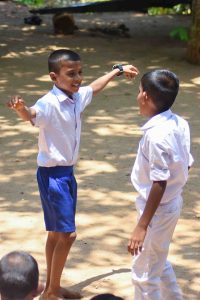
Program to the Primary and Preschool students:
Introduction to different wildlife
This session was done as a game of passing a hat around a circle. A picture of an animal or a plant would be shown to the kids while the child with the hat had to guess the animal with the features they say. The children were given a small sweet as they guessed the animal
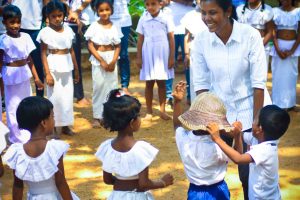
Introduction and use of binoculars and spotting scope
The binoculars and spotting scope that we used for field craft were also brought to the community service programme to give the children hands on experience on using them. Some of them have never even heard of these instruments.
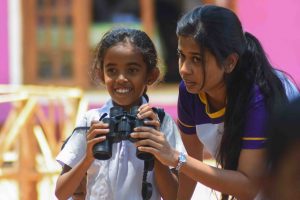
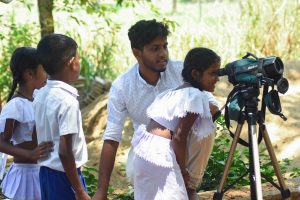
The children were taught to look at far away objects with the instruments and they were asked to describe them. Pictures of animals were held at a distance and they were asked to go in a straight line towards the picture while looking through the binoculars. Every child had the chance of using a binocular by themselves
Hand printing, creative session
-A painting was created by applying paint on the children’s hands and printing it on to a paper to create scenery of wildlife. They created trees, birds, elephants, peacock, monkeys, bears, tigers, fish and frogs.
Learning to draw animals with letters
-Through this session, the children were given stationery and they were taught how to draw animals with different letters they knew.
Refreshments, Awarding of Gifts and conclusion of the program:
The children gathered back to the hall for refreshments. The headmaster of the Sunday school addressed the gathering and thanked us for organizing such an event for these children. Smiles of happiness shone radiantly from the faces of the children as they received their gift packs.
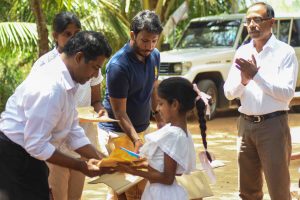

It was a delight to see the beaming faces of these little flowers with every new experience they gained. The way they keenly involved in the activities and how they came forward to take part.
The communities that live around Wasgamuwa National Park are a main stakeholder group involved with the Park. They constantly interact with the wildlife of the Protected Area. Interacting with these communities is an essential skill required in Wildlife Management.
One major concern in these communities is the gradual loss of traditional value towards nature and increasing unauthorized and destructive activities towards wildlife in their associated protected area. The socio economic environment, lack of inspiration and ignorance are the reasons for this issue. It is important to teach the younger generations to coexist with their inherent wildlife resources to prevent this diversion.
We, on the other hand gained so many skills on teamwork, leadership, organizing an event and even on how to approach one when delivering our message. We learnt how to integrate different ideas together and create a successful and diverse program.
Therefore this educational program was an important component of this course unit that gave hands on experience to the students following the course as well as a service to the community.
Acknowledgement:
- Prof. P. N. Dayawansa, Professor in Zoology and Environment Science, Department of Zoology and Environment Science, Faculty of Science, University of Colombo
- Mr. Mahinda Wijayasinghe, Wildlife Ranger, Department of Wildlife Conservation
- Mr. Chandima Fernando, Ecologist, Sri Lanka Wildlife Conservation Society
- Ms. Nisansala Perera and Ms. Manasi Somachandra, Demonstrators, Department of Zoology and Environment Science, Faculty of Science, University of Colombo
Image Courtesy: Mr. Dushantha Kandambi

